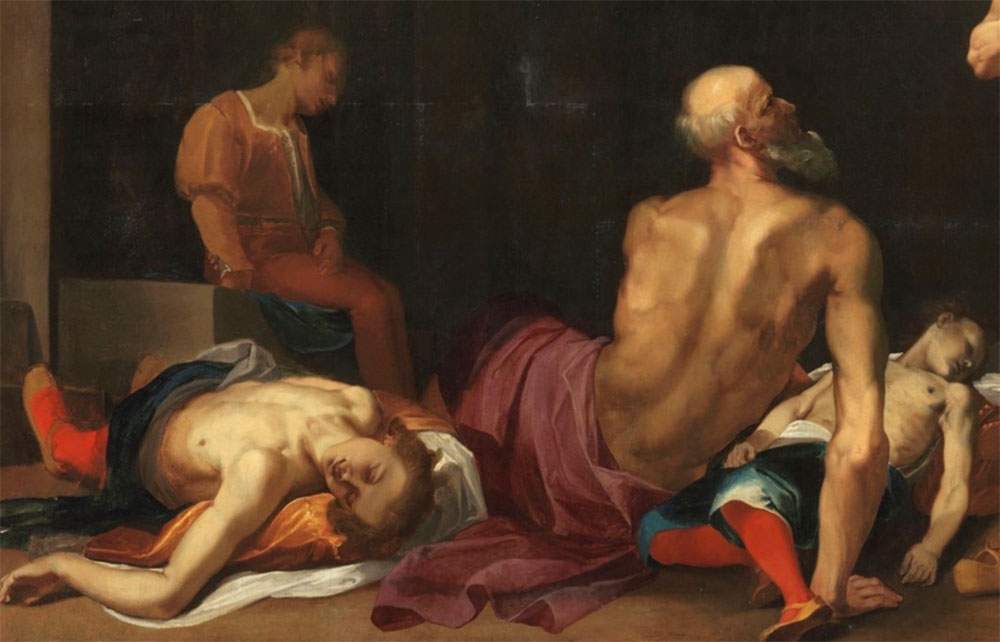Important seventeenth-century Dante painting featuring Count Ugolino arrives at the Uffizi as a gift
A prestigious and rare Dante acquisition arrives at the Uffizi on the occasion of the Celebrations for the Seven Hundredth Anniversary of the Death of Alighieri. In fact, the museum has received as a gift a canvas by Fra’ Arsenio, born Donato Mascagni (Florence, c. 1570 - 1637) depicting Count Ugolino, circa 1611. The work was donated by the Friends of the Uffizi Gallery, the American branch of the Friends of the Uffizi.
The canvas, which is large in size and also striking in its impact, will soon be on temporary display in the Niobe Room on the second floor of the Statues and Paintings Gallery, where it will remain until the end of the Dante year. The painting is linked to one of the most famous episodes of the Divine Comedy, described in the XXXIII canto of the Inferno, the celebrated one whose protagonist is Count Ugolino della Gherardesca, included among the traitors of the homeland, which for Dante was the third most infamous sin (after betrayal of guests and betrayal of benefactors). For this reason, Ugolino is plunged into the ninth circle, in the area of Antenora, the area where traitors to the homeland are plunged into the icy waters of the Cocito with their faces upward.
In historical reality, the Pisan nobleman was imprisoned along with two sons and two grandsons in the Torre della Muda in Pisa, and there condemned to starve to death. The Supreme Poet narrates the story, concluding it with the famous line “Poscia, più che ’l dolor, poté ’l digiuno,” recalling how Ugolino out of desperation had eaten the flesh of his relatives: a part of the heinous and bloody story that Friar Arsenio avoided, preferring the no less dramatic, but much less gruesome, moment of the last stages of their slow agony. The painting depicts the scene that precedes the tragic denouement, the one corresponding to the triplet “as a little ray was put / in the sorrowful prison, and I scanned / for four faces my very appearance.” In the visual rendering of Dante’s verses, Fra’ Arsenio reaches the climax of the drama: in the foreground a livid light reveals two already lifeless bodies, while in the background a young man slumps, consumed by hunger. On the right stands a trembling nude, close to death; Ugolino in the center, depicted from behind, helplessly watches the end of his loved ones before dying himself. The bodies stand out against a dark background, illuminated by a raw beam of light that highlights the anatomies, rendered in their physical misery with inexorable anatomical exactitude. The angularity of some of the profiles reveals the attention to truth and naturalistic vocation of Friar Arsenio, who in Florence had probably assimilated these stylistic features from Jacopo Ligozzi and the fresco cycles of Bernardino Poccetti.
The attribution of the canvas to the painter is due to Mina Gregori, a pioneer of studies on the Florentine seventeenth century: thanks to the unmistakable subject, in texts of the time the scholar traced the painting’s original location to the Spezieria del Convento Servita della Santissima Annunziata in Florence, where it remained until the second half of the nineteenth century. Friar Arsenio, born Donato Mascagni, entered the hermit community of the Servants of Mary of Montesenario in 1605; from 1608 to 1614 he was an intern at the Florentine convent of Santissima Annunziata, where he created the work that has just entered the Uffizi. The value of the work is also given by the rarity of the subject for the time. From the Middle Ages, in fact, a conspicuous number of illustrations of the Divine Comedy on paper are known (the Uffizi possesses the splendid series dedicated to it with 88 sheets drawn by Federico Zuccari in the 1680s), while until the nineteenth century, representations in painting or sculpture of episodes from Dante are rather scarce.
“Precisely in the year of Dante, thanks to a generous gift from the Friends of the Uffizi Galleries,” says Uffizi Galleries Director Eike Schmidt, “the museum is enriched with a rare and sophisticated work, previously shown to the public only on the occasion of the major exhibition on the Florentine seventeenth century at Palazzo Strozzi in 1986. It is an early testimony to the fortune of the Divine Comedy in monumental figurative culture: before this painting, only Pierino da Vinci (in a bronze bas-relief now in the collection of the Prince of Liechtenstein) had tried his hand precisely at the scene of Count Ugolino, a subject that only from the late eighteenth century would be frequently visited.”
“It was thanks to the nonprofit association affiliated with us, Friends of the Uffizi Gallery, that we were able to purchase and donate Mascagni’s ’Il Conte Ugolino’ to the Uffizi,” says Maria Vittoria Rimbotti, president of the Friends of the Uffizi Maria. “This work, reminiscent of a Tuscan character contemporary to Dante Alighieri, is part of Florence and it is only right that the Florentines have it back.”
Image: Fra’ Arsenio, Count Ugolino, detail (c. 1611; oil on canvas, 148 x 206 cm; Florence, Uffizi Galleries)
 |
| Important seventeenth-century Dante painting featuring Count Ugolino arrives at the Uffizi as a gift |
Warning: the translation into English of the original Italian article was created using automatic tools. We undertake to review all articles, but we do not guarantee the total absence of inaccuracies in the translation due to the program. You can find the original by clicking on the ITA button. If you find any mistake,please contact us.




























